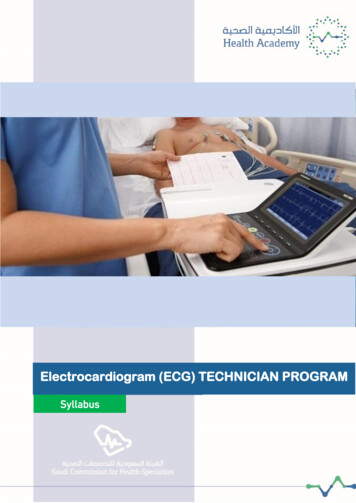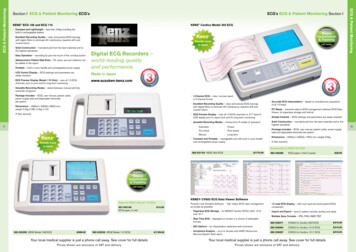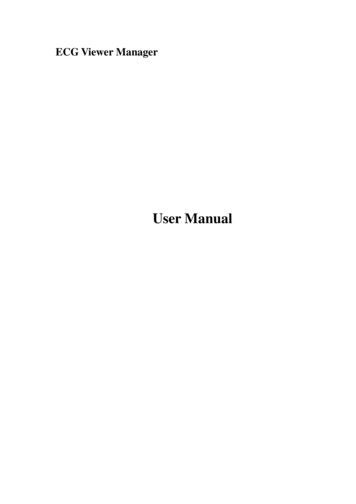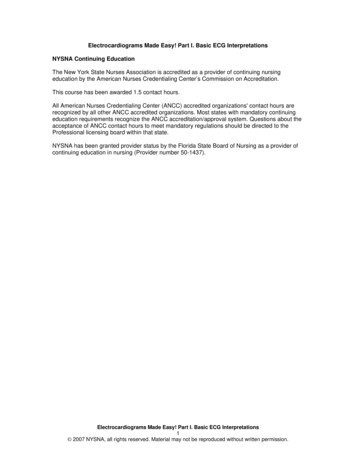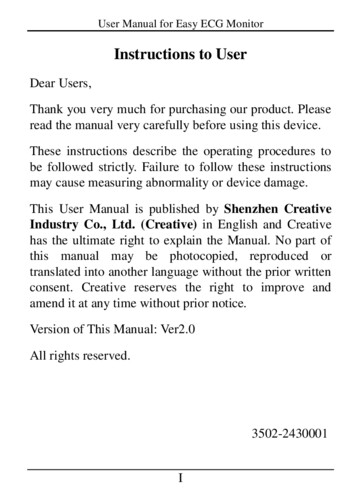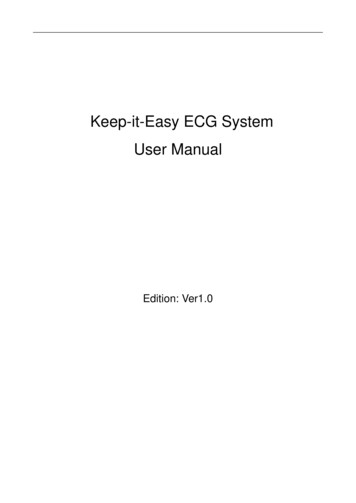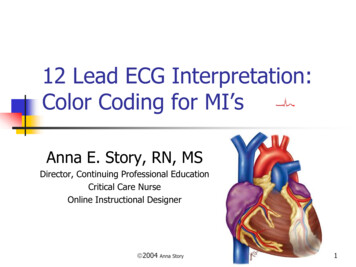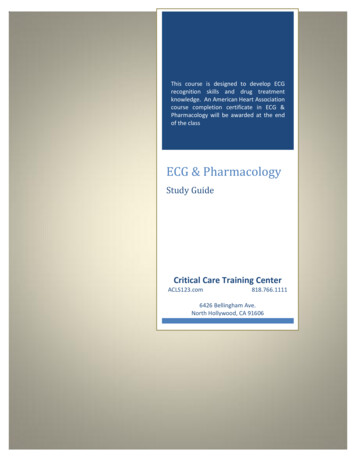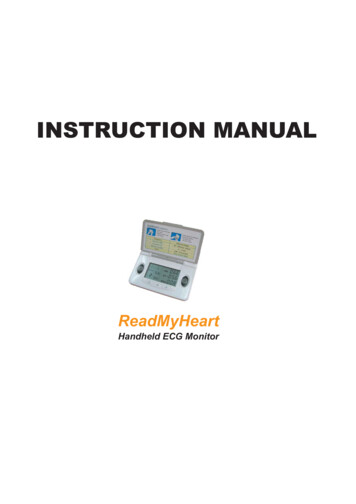
Transcription
INSTRUCTION MANUALReadMyHeartHandheld ECG Monitor
IMPORTANT NOTICE 2009 DailyCare BioMedical, Inc. All rights reserved. No partof this publication may be reproduced in any mannerwhatsoever without written permission from the owner.Proprietary rights of DailyCare BioMedical are involved with thesubject matter of this document and all manufacturing,reproduction, use, and sales rights pertaining to such subjectmatter are expressly reserved. The recipient, by accepting thisdocument, agrees that the information contained herein will notbe copied or reproduced in whole or in part, nor its contentsrevealed in any manner or to any person, except to meet thepurpose for which this document was prepared and deliveredwithout the express permission of DailyCare Biomedical Inc.MEDICAL DEVICE WARRANTYDailyCare Biomedical Inc warrants each new device to be freefrom defects in material and workmanship. This warranty is nottransferable. This warranty is effective for a continuous periodof one year from initial date of shipment against the originalorder to the original purchaser. This warranty covers parts andlabor costs when, upon examination by the manufacturer, thedevice is determined to be in fact defective. In order toimplement the provisions of warranty repair, the purchaser mustnotify DailyCare Biomedical Inc concerning suspected defectsand then, if so instructed, ship the instrument to the designatedfacility, correctly packed in an appropriate shipping container,for examination and servicing. www.dcbiomed.comHHI
LIMITATIONS AND EXCLUSIONSThis warranty does not cover repairs necessitated by anydamage to equipment caused by mishandling, neglect, abuse,customer modification or failure of the user to follow rewarranted for a period of 30 days and are subject to thelimitations and exclusions described in this document.DailyCare Biomedical Inc reserves the right to make designchanges in its products without incurring the obligation ered. This warranty applies unless DailyCare BiomedicalInc has agreed to and provided a written exception to thispolicy.II
ATTENTION!DailyCare Biomedical Inc assumes no responsibility forany personal injuries or damages sustained by or throughuse of this product.ReadMyHeart will NOT tell you if you have heart problems. Only yourphysician can do that. You should NOT interpret themeasurement results yourself. is NOT a diagnostic device. It is only an ECG recorder. is NOT a substitute for a traditional ECG diagnosis. is NOT recommended for users with pacemakers.What you should not do: Do NOT operate ReadMyHeart while using other electricaldevices. Do NOT connect ReadMyHeart to the PC via USB cablewhen acquiring ECG. Do NOT use accessories other than those provided by themanufacturer. Do NOT use USB cable other than thatsupplied by manufacturer. Do NOT subject the device to water and liquid spillage. DoNOT clean with alcohol, acetones or any other flammablechemical agents. Do NOT use with any lotions. Do NOT place the device and its accessories under directsunlight and harsh environments. Do NOT disassemble ReadMyHeart. It may cause devicemalfunction, device failure or damage and you will looseall warranty.III
ATTENTION!Please use the device properly by following standardoperating procedure. (Please refer to Section 2.2 Page 9)Improper use of the device will cause inaccuraterepresentation of measured results. NOISE indicator mayappear if the device is not operated correctly. If youreadings are NOT within the reference range, multiplereadings are recommended.As a rule, if you are feeling uncomfortable, regardless ofthe numbers and symbols on the device, please consultyour physicians immediately!IV
Table of ContentsIMPORTANT NOTICE . IMEDICAL DEVICE WARRANTY . ILIMITATIONS AND EXCLUSIONS . IIATTENTION! . IIIINTRODUCTION . 11.1 WHAT IS READMYHEART . 11.2 BENEFITS OF READMYHEART . 21.3 ECG VARIABLES . 31.4 COMMON CAUSES OF ABNORMAL ECG TRACINGS . 41.5 BASIC FUNCTION OF THE HEART . 41.6 CONDUCTION SYSTEM OF THE HEART . 5PRODUCT DESCRIPTION. 62.1 PRODUCT DESIGN . 62.1.1 Main Unit. 62.1.2 Control Buttons . 72.1.3 Product Package . 82.1.4 Product Label. 82.2 TAKING A MEASUREMENT . 92.2.1 Dry Thumb Conduction Electrodes . 92.2.2 Optional External Electrode Cable. 102.3 DISPLAY PANEL .112.3.1 LCD Display.112.3.2 LCD Display Description. 12V
2.4 PRODUCT SPECIFICATIONS .13READMYHEART SOFTWARE .143.1 SYSTEM REQUIREMENTS .143.2 INSTALLATION .143.3 TRANSMIT DATA .153.4 SOFTWARE INTERFACE .183.5 USER MANAGEMENT .193.5.1 Add a New User.203.5.2 Display or Change User’s Information.213.5.3 Search for User .223.5.4 Move ECG file to other User folder .223.5.5 Delete, E-mail, Save, Preview and Print a File.233.5.6 Set report header.233.5.7 Review ECG Trace and Parameters .253.5.8 Redefine ECG Parameters.263.5.9 Reading the Graph .273.5.10 ECG Waves and Parameters .28FREQUENTLY ASKED QUESTIONS .30GLOSSARY.34REFERENCES .36CONTACT INFORMATION .37VI
INTRODUCTION1.1 What is ReadMyHeartReadMyHeart is a non-invasive, handheld heart monitoringdevice. It allows users to measure and record electrical activitiesof the heart anywhere and anytime. It records and displaysreal-time electrocardiogram (ECG).Electrical signals of the heart can be obtained using two methods.The first method is by placing thumbs on ReadMyHeart’s speciallydesigned dry conducting electrodes. The second method is byusing external electrode cable and adhesive ECG electrode pads.ReadMyHeart records 25 seconds of “Modified ECG signal” 1 foreach measurement. After measurement, the device will instantlydisplay the average of 3 parameters on the LCD panel: theaverage heart rate (HR), ST segment deviation (ST) and QRSinterval (QRS).These parameters are not the traditionalstandard ECG readings, but rather, a “Modified Lead I -ECG”2 .FFFFReadMyHeart can transfer all recorded measurements to apersonal computer through USB connection for management andanalysis of ECG data.1ReadMyHeart uses two conducting electrodes to measure cardiac activities, unliketraditional ECG device which requires at least 3 electrodes. ECG measured byReadMyHeart is designated as a modified Lead I ECG.2These parameters from ReadMyHeart are for reference only. For interpretation of theparameters, please consult professional physicians. Additional standard 12 lead ECGtest may need to be performed.1
1.2 Benefits of ReadMyHeartReadMyHeart is a recording device used to monitor or spot-checkthe electrical activities of the heart anytime and anywhere. It isdesigned to be small, portable and easy to use.WithReadMyHeart you can: The New Vital SignReadMyHeart enables qualified medical personnel toquickly spot-check for irregular heart beat during primaryassessment. Take measurements anytime anywhereReadMyHeart’s compact design allows the user to carry thedevice anywhere, anytime for periodic monitoring of his/herheart throughout the day. Manage ECG recordings over timeReadMyHeart software allows users to manage ECGrecording with a time stamped record. Patient to PhysicianData generated by the ReadMyHeart can be printed, faxed,or emailed using the accompanying software. TheReadMyHeart also stores up to 30 records2
1.3 ECG VariablesFigure 1. Normal ECG Waveform (Lead I)Figure 1 is a presentation of a normal ECG waveform from Lead I.ReadMyHeart uses patented algorithms to identify and computeparameters in the table listed below. Table 1 is a list of ECGparameters measured by ReadMyHeart.Table 1 ReadMyHeart Output ParametersParametersReference RangeAverage Heart Rate (HR)* 60 HR 100 bpmST Segment (ST)*-2 ST 2 mmQRS Interval (QRS)*0.08 sec QRS 0.12 secPR Interval0.12 0.20 secQT/QTC0.32 0.44 sec / 0 .41 0.44 sec* The hardware only shows HR, ST and QRS. The PR and QT/QTc willbe provided in analysis software (provided) on your computer.3
1.4 Common Causes of Abnormal ECG TracingsAbnormal ECG tracings may be caused by many different factors,including: Coronary artery disease Electrolyte imbalances in your blood (such as sodium orpotassium) Changes in your heart muscle Injury from a heart attack Healing process after heart surgeryPlease consult your physician if you are concerned about yourECG recording and symptoms to get more information about yourcondition.1.5 Basic Function of the HeartThe heart has 4 chambers that act together to pump bloodthroughout the body. The 2 smaller upper chambers are calledatria, and the larger lower chambers are called ventricles. Theright atrium receives oxygen-depleted blood coming back fromthe body via 2 large veins: the superior vena cava and inferiorvena cava. The right atrium pumps this blood into the rightventricle, which then pumps the blood into the lungs, which isoxygenated. The blood then comes back into the left atrium,which is then pumped into the left ventricle. The left ventriclethen pumps the blood back to the circulatory system via the aorta,the largest artery in the body. The pressure that the left ventricleexerts to keep the blood moving throughout the whole body is theblood pressure.4
1.6 Conduction System of the HeartThe chambers of the heart pump with the automatic discharge ofelectricity from the sinoatrial (SA) node, a group of specializedcells in the right atrium. On average, there are 60 to 100 timesdischarges per minute. When the SA node discharges, bothatria contract, and the electrical impulse is relayed to theatrioventricular (AV) node that is between the 2 ventricles. Theelectrical wave that is propagated across the AV node causesboth ventricles to contract and pump blood. The normal delaybetween the atrium and ventricle contractions is 0.12 to 0.20seconds. By studying the electrical activity that results whenheart muscle cells contract, we gain insight to the health andworkings of the heart. These electrical activities can be detected,recorded and studied with ECG monitoring device, for exampleReadMyHeart.5
PRODUCT DESCRIPTION2.1 Product Design2.1.1 Main UnitFrontCoverLCD DisplayLeft ThumbElectrodeRight ThumbElectrodeTime settingOn/Off/Start ButtonData Transfer ButtonData Recall ButtonBattery coverExternal AuxiliaryElectrode SocketSliding SocketCoverUSB CableSocketProduct Label6
2.1.2 Control ButtonsControl Button DescriptionsButtonsDescriptionsOn / Off / Start Button Press once to power on and start measurement. Hold for 3 seconds to power off.(Button 1) After measuring, press again to start anothermeasurement.Data Recall button / Data Clearance Press once to enter data recall mode. The latest datarecorded will be displayed. Press again to recall other recorded data, starting fromthe first.(Button 2) Hold for 3 seconds, or press any other button, to leavedata recall mode.andtogether for 3 seconds to manually Holdclear all stored data.Data Transfer Button / Data Clearance Connect ReadMyHeart to PC with USB cable andpress once to start transferring of stored data.(Button 3)andtogether for 3 seconds to manually Holdclear all stored data.Time Setting When the device is on, press once to set the right time.(HiddenButton) Press Button 2to select month/date/time. Press Button 3to adjust value.Note: Only use USB cable provided by manufacturer. OtherUSB cables will cause serious damage to device. Pleasevisit: www.InstantCheck.com to re-order USB cable.7
2.1.3 Product PackageStandard Package:;ReadMyHeart deviceX1;ReadMyHeart Software CDX1;ReadMyHeart User’s ManualX1;Carrying CaseX1;USB CableX1;Auxiliary Electrode CableX1Not Included:1)2)Electrode gel pad. These pads can be purchased at local drugstores.AAA alkaline battery. ReadMyHeart needs two to operate.2.1.4 Product LabelAttention, consultACCOMPANYINGDOCUMENTPRODUCT BATCHNO.TYPE BFAPPLIED PARTCERTIFIED CEMARKING, NOTIFIEDBODY NO. 0197ReadMyHeart is TYPE B EQUIPMENT WITH F-TYPE APPLIED PARTIN EN IEC60601-1 STANDARD8
2.2 Taking a Measurement2.2.1 Dry Thumb Conduction ElectrodesOpen the cover ofReadMyHeart.StepsPressonce to startmeasuring. (Allow 30memories)LCD screen willdisplay the parametersafter measurement.Descriptions1Wash and dry your hands before use.2Sit down and place your hands comfortably on a table or onyour laps. Hold ReadMyHeart in your hands steadily. Calmand relax yourself with regular breathing.3Pressonce and place right and left thumbs gentlyon the conduction electrodes to start measurement.- During measurement, a timer will be displayed at theright bottom corner of LCD screen.- During the 25 seconds of measurement, avoid talkingand keep a steady but gentle contact of the thumbs tothe conduction electrodes.- ReadMyHeart can store up to a maximum of 30 datafiles. The device will stop recording. If you want to do thenext measurement, you need to transfer data to PC, orerase the memory. Record number will start to flash at26th data files to remind you that memory is almost full.- Three parameters of the measured results will bedisplayed on the LCD screen.To start anothermeasurement, simply pressagain. Please notethat ReadMyHeart cannot be powered off duringrecording.9
4Holdfor 3 seconds to power off the device.ReadMyHeart will be powered off automatically if left idle formore than 2 minutes to save power.2.2.2 Optional External Electrode CableReadMyHeart has optional auxiliary electrodes as an alternativeway for users to take ECG readings. Please follow the stepsbelow when using the auxiliary electrodes:Steps1DescriptionsPlace the sticky electrode pad (not included) on the middle ofthe inner forearms.(Users can buy qualified electrode pads from anymedical device stores.)2Slide the socket cover to expose theoptional electrode socket, and connectthe cable to ReadMyHeart accordingly.Please connect the RED electrode onthe right arm and the BLUE electrodeon the left arm as shown in figure onthe right.3Start the measurement as described above. (Section 2.2.1)NOTE: Both auxiliary electrode and USB sockets on the deviceare to be used only with the standard accessories provided.Warranty will NOT cover damages that result from failure tocomply with these instructions.10
2.3 Display Panel2.3.1 LCD Display172834956Figure 2. LCD Display PanelReference Range of Measured ResultsReference RangeWarning SignHR60 HR 100 bpmFlashST-2 ST 2 mmFlashQRS0.08 QRS 0.12 secFlashAttention: The information above is for reference ONLY. If themeasured parameters fall within the reference rangeand user feels any discomfort, user should contact aphysician. Measured data by RMH may be providedto a physician for reference, monitoring, or furtheranalysis.11
2.3.2 LCD Display Description#ItemDescriptions1Displays when ReadMyHeart is searching forsignals. (Takes around 3 5 seconds)2Flashes when measurement is in progress.Flashing stops when measurement is completed.3Displays when ReadMyHeart is in data recallmode.4Displays when ReadMyHeart is transferring data.5TotalNumber/Data FileNumber6BatteryConditionDuring power on mode, the number represents thetotal number of data files recorded. In data recallmode, the number represents the serial number ofdata file being displayed.indicates the battery is normal.indicates the battery is low.is displayed after measurement when noisysignals are detected more than 5 times duringmeasurement. PLEASE MEASURE AGAIN.7Note: Under above conditions, parametersdisplayed on LCD may not be accurate but will stillbe stored in the device.8HRAverage Heart Rate of 15 seconds. Flashes rightafter measurement when the numbers are out ofreference range.9STST segment. Flashes right after measurementwhen the numbers are out of reference range.QRSQRS interval. Flashes right after measurementwhen the numbers are out of reference range.Date/TimeMonth/Day/Hour/Minute12
2.4 Product SpecificationsInput impedance 10 M - OhmInput dynamic range /- 2 mVBandwidth0.15 – 40 HzCMRR(Common Mode Rejection Ration) 60 dbA/D conversion12 bitSampling frequency250 samples/sec 25 secondsMeasurement Time(First 10 seconds is to search forsignals)DisplayLCD display panelInputDry conduction electrodes and/orexternal auxiliary electrodesOutputUSB interfacePower Supply1.5V (AAA) X 2Size12 8 2 cm134 gWeight(Not including batteries)Environmental Conditions:Storage temperature-4 F 122 F (-20 C 50 C)Operating temperature50 F 104 F (10 C 40 C)Humidity25% 95%Measurement Range:Average heart rate45 to 180 bpmST segment-3 to 3 mmQRS interval 0.20 sec13
ReadMyHeart SOFTWARE3.1 System RequirementsOperating System: Windows 98/98SE/2000/XP/VistaHardware Requirements:¾ CPU: Pentium III and above¾ Memory: 100MB and above¾ Hard Disk capacity: 100MB and above¾ Data transmission media: Universal Serial Bus (USB)¾ Screen resolution: 1024 x 7683.2 InstallationFigure 3. ReadMyHeart Software Main PageInsert ReadMyHeart software CD into the CD-ROM. Select“Software Installation” from the main page and setup will runautomatically. If auto-installation does not start, double click onthe “autorun.exe” application file in the CD to install manually.Follow the Setup Wizard instruction on the screen.14
3.3 Transmit DataAll data files recorded in ReadMyHeart can be transferred to PCfor analysis through the USB port on the left side of ReadMyHeartshown in below. Slide the socket cover to expose the USB socket.Only use USB cableprovided bymanufacturer totransmit data.USB portReadMyHeart USB portSteps for file transfer. Please follow the following steps:1. Start the ReadMyHeart software by selecting DailyCareBiomedical Inc Æ ReadMyHeart from the File Menu or byclicking on theon your desktop.2. A “Disconnected” status will be shown initially on the bottomleft of the main menu.Connect one end of the USB cable (small) to the USB socketon the hardware first (A). Then connect the other end of the15
USB cable to the USB port on the computer (B).Send(B)Connection of USB Cable(A)3. When the USB connection detected, it will be indicated on thebottom left corner of the software screen.Only use USB cable provided by manufacturer to transmit16
4. Presson ReadMyHeart andwill appear on theLCD display, indicating a transfer of the data files to the PC.The number belowis the serial number of the data filescurrently downloading to the PC. A transmission window willappear on the PC to show data transmission in progress asshown below.Data TransmissionStatusData Transmission Progress WindowNote: Please confirm/select the right user before thetransmitted data save to the PC. The user confirm windowshown as below.Note: After data files have been successfully transferred to thePC and when you start your next measurement, ReadMyHearthardware will erase its memory automatically.17
Note: The default file name is the time-stamp of the reading. Byclicking the selected file name, the user can change the name.Note: Ifflashes after pressingor during file transfer,it means the connection between ReadMyHeart and the PChas failed. Please close and then re-start the software again,and/or reconnect the USB cable.3.4 Software Interface4123Figure 4. ReadMyHeart Software and Database Interface Details18
ReadMyHeart has a simple analysis interface as shown in Figure4. This analysis and database management system is dividedinto four main parts:(1) User and file management;(2) Average ECG parameters display and remarks;(3) Connection status of ReadMyHeart to PC;(4) ECG waveform diaplay (Maximum of 15 seconds).3.5 User ManagementUser managementFunction KeysFile ManagementDescriptionAdd a new userDisplay and change user’sinformationDelete selected userSearch for userMove ECG file to other user folderDelete selected file19
Email ECG dataSave ECG waveform as graphic filePreview ECG report for printingPrint ECG reportView between 10mm/mV or20mm/mVSet report’s headerDetailed descriptions of Function Keys are as follows:3.5.1 Add a New User1. To add a new user, click onfunction key. The “Createnew user” window will appear as shown below.2. Enter user information such as name, sex, ID, weight, date ofbirth (DOB) and height.3. Click onAddand a new user will be added to the userinformation list. Name of user must be keyed. Otherwise, a20
warning window will appear.4. Repeat step 1 and 2 to add more new users.5. Click onXto close the user management window.3.5.2 Display or Change User’s Information1. Select a file/user first.Step 2Step 12. Selectfunction key. The user’s information will appear asshown below.Step 3You can modify the values on the table after clickThen clickModify .Save , all the modified values will be savedautomatically. ClickExit , The values will NOT be changed.21
3.5.3 Search for User1. Selectfunction key. A window will appear. You can searchby “User Name” or by “ID”. Please type in your searchcharacters in the String field.2. SelectFindto start finding. If the user is found, the namewill be highlighted.3.5.4 Move ECG file to other User folder1. Select the files first (Multiple files can be selected).Step 2Step 12. Clickfunction key. A window will appear. You can movethe selected ECG file to other user.22
Step 33.5.5 Delete, E-mail, Save, Preview and Print a File1. .Select the files first (Multiple files can be selected).Step 2Step 12. Click delete, email, save, preview, or print function.3.5.6 Set Report Header1. Selectfunction key. The “Report information” window willappear as shown below.23
2. Enter header information. Click onSave , and the headerinformation will show on the top of the ECG report.24
3.5.7 Review ECG Trace and ParametersQ1Q21. Select a user and click on a file.2. A 15 seconds ECG trace will be shown on the right side of thescreen in quadrant 1. (Q1)NOTE: If you stop ECG measurement in less than 25 seconds,you will not have the full 15 seconds ECG trace.3. The average ECG parameters (HR, PR, QRS, QT, QTc, ST)will be displayed in quadrant 2. (Q2)4. You can also select a particular section of the ECG trace, by25
clicking left click once to start and left click again to end thesection in Q1. The selected part of the trace will turn blue. Theaverage ECG parameters will be displayed in Q2 accordingly.3.5.8 Redefine ECG ParametersThis section is highly recommended for doctors only. Thepower of the device lies in the algorithm which identifies anddefines P, Q, R, S and T wave intervals to generate theparameters observed on the file. The algorithm is highly preciseand accurate which is observed in a correlation study withstandard ECG device.In order to present a flexible format, the software is developedwith the ability to redefine the waves. This should only be doneby a medical professional who has great experience with ECGanalysis and interpretation. Therefore, users are stronglyadvised against performing the function in this section unlessunder the guidance of a medical professional.26
Steps to redefine ECG waves:1. ECG parameters will be calculated automatically.2. If you click on the vertical bars on the ECG waveform, it willchange to a red bar. Use the left and right arrow key tomove it. The software will automatically recalculate theparameters.3. Left click on the ECG waveform after you have finishadjusting the bar.3.5.9 Reading the GraphThe Y-axis represents voltage in mV.The bar indicatedbelow represents 1millivolt (mV). This denotes the electricalstrength of the signal. Therefore, each big square represent0.5 mV and each small square represent 0.1mV.27
The X-axis represents time in seconds.Each big squarerepresents 0.2 seconds. Therefore, each small squarerepresents 0.04 seconds.1 bar 1mV0.2 secondsECG graph3.5.10 ECG Waves and ParametersThe following is a summary of the ECG wave morphologiesand parameters that users can use as a guide to interpret theirECG recordings.For more technical information, pleaserefer to the reference section.¾ P wave: The P wave results from atria contraction. P waveis generally about 1 box wide or 1 box tall. P wave thatexceeds these might indicate atria hypertrophy, i.e.,enlargement.¾ PR Interval: The PR interval is measured from the start ofthe P wave to the start of Q wave.It represents theduration of atria depolarization. Normal duration is from28
0.12 to 0.20 seconds.If the PR interval is greater than0.20 seconds, then an AV block might be present.¾ QRS Duration: The QRS duration is measured from thestart of Q wave to the end of S wave. It represents theduration of ventricle depolarization.from 0.08 0.12 seconds.Normal duration isIf duration is longer, it mightindicate presence of bundle branch blocks.¾ QT/QTc: The QT/QTc is measured from the start of the Qwave to the end of T wave.QT interval represents theduration of activation and recovery of the ventricularmuscle. This duration varies inversely with the heart rate.The normal QTc is approximately 0.41 seconds, it iscorrected with the heart rate with the following formula to getQTC:QTC QT / sqrt (RR)RR is interval between R to R peak.¾ ST Segment: The ST segment is measured from end of Swave, J point, to the start of T wave.This segment isimportant in identifying pathology such as myocardialinfarction (elevation) and ischemia (depression).To learn more about the analysis of ECG parameters, please referto the list of references provided in the Reference Section.29
FREQUENTLY ASKED QUESTIONSQ1: What is ReadMyHeart?A1: ReadMyHeart is a personalized, home care heart monitoring device.The main function of ReadMyHeart is to record ECG tracings anywhereand anytime. Using uniquely designed dry electrodes, users only needto place both thumbs on the electrodes, and their ECG will be recorded.The parameters measured will be displayed on the LCD screen.Together with the software, users can transfer data files to PC for themanagement of data.Q2: Why does “Noise” appear during measurement?A2: ReadMyHeart measures the electrical activities emitted by the heart.The “Noise” is the interference with the recording of these signals dueto poor contact between the thumbs and the electrodes, excessivemovement of the body, and other the environment, etc. When usingReadMyHeart, it is recommended that users take a stable sittingposition, with their feet insulated from the ground. Please measureagain when “Noise” appears on LCD screen after the device finishesrecording. For detailed operating procedure, please refer to P.9 of theUser’s Manual.Q3: What are some of the factors that may affect the measurement byReadMyHeart?A3: Besides the factors mentioned in Q2, the followings are some of thefactors that may also affect measurements:1. Thumbs may be greasy, which may affect the transmission ofsignals. Please use clean water to clean thumbs.2. Thumbs may be too dry. DO NOT use cream. Please use externalauxiliary electrode cable & sticky electrode pad.3. Contact pressure between the thumbs and the electrodes may betoo strong. Please place thumbs on the electrodes gently.Even when users have followed the regular procedure described in theUser’s Manual to operate ReadMyHeart, the user may still experience aweak signal. Please contact the distributor, retailer, or visit DailyCareBioMedical’s website: www.dcbiomed.com.HH30
Q4: How do you use the optional auxiliary electrodes?A4: The optional auxiliary electrodes are for users who cannot holdReadMyHeart steadily without shaking, or users whose thumbs are toodry. For detailed instructions, please follow the steps described inP.10 of the User’s Manual. Please note that the electrode pads are NOTincluded. Please buy the electrode pads from a medical device store.Q5: Can ReadMyHeart be stopped or powered off in the middle of themeasurement?A5: During the 25 seconds measurement, ReadMyHeart cannot be stoppedor powered off.Q6: Will static electricity affect the measurement of R
standard ECG readings, but rather, a "Modified Lead I -ECG" F 2 F. ReadMyHeart can transfer all recorded measurements to a personal computer through USB connection for management and analysis of ECG data. 1 ReadMyHeart uses two conducting electrodes to measure cardiac activities, unlike traditional ECG device which requires at least 3 .
